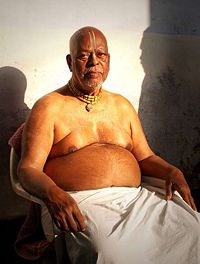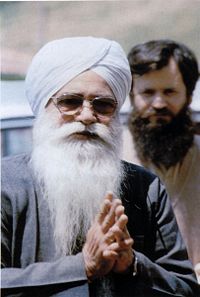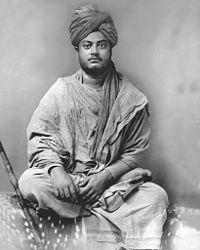Difference between revisions of "Hindu leadership" - New World Encyclopedia
Anne Inoue (talk | contribs) (possible sites for sannyasa) |
Anne Inoue (talk | contribs) (ext link) |
||
| Line 114: | Line 114: | ||
* [http://www.ariseawake.com/poems/TheSongoftheSannyasin.html 'The Song of the Sannyasin', poem by Swami Vivekananda] | * [http://www.ariseawake.com/poems/TheSongoftheSannyasin.html 'The Song of the Sannyasin', poem by Swami Vivekananda] | ||
* [http://www.gosai.com/chaitanya/saranagati/html/vishnu_mjs/meaning_of_sannyasa/sannyasa.html The Internal Meaning of Sannyasa] | * [http://www.gosai.com/chaitanya/saranagati/html/vishnu_mjs/meaning_of_sannyasa/sannyasa.html The Internal Meaning of Sannyasa] | ||
| + | * [http://www.hinduwebsite.com/hinduism/essays/brahmanaspriest.asp The concept of a Brahman] | ||
Revision as of 17:32, 28 September 2008
| Part of the series on Hinduism | |

| |
| History · Deities | |
| Denominations · Mythology | |
| Beliefs & practices | |
|---|---|
| Reincarnation · Moksha | |
| Karma · Puja · Maya | |
| Nirvana · Dharma | |
| Yoga · Ayurveda | |
| Yuga · Vegetarianism | |
| Bhakti · Artha | |
| Scriptures | |
| Upanishads · Vedas | |
| Brahmana · Bhagavad Gita | |
| Ramayana · Mahabharata | |
| Purana · Aranyaka | |
| Related topics | |
| Hinduism by country | |
| Leaders · Mandir · | |
| Caste system · Mantra | |
| Glossary · Hindu festivals | |
| Murti | |
Hinduism is an umbrella term for various religious traditions that originiated in India, and now are practiced all around the world. The third largest organized religion in the world, after Christianity and Islam, Hinduism is based on an ancient religion, the Veda, that was brought to India around 1500 B.C.E. by the Aryans. The social stratification of the Aryan society also influenced India, and along with Hinduism, a number of social classes, called castes, simultaneously developed after the Aryans' arrival.
Just as Hinduism includes a variety of religious traditions, the religious leaders in Hinduism include a variety of different hierarchies. According to the strict interpretation of the caste system, all priests must come from the highest, or Brahman caste. Generally a person was compelled to remain in the same caste into which he was born, and could how to be born into a higher caste at his next reincarnation. This means that in most cases, the priesthood was hereditary. Besides the Brahman priests, Hinduism also has monastic orders, referred to as Sannyasa. A third category of religious leaders in Hinduism are referred to as gurus, or teachers.
Hinduism includes a variety of gods, religious practices, religious leaders. Each person's faith is an individual matter, and each will choose a guru that suits the goals and nature of his faith. All of these religious leaders have a responsibility to guide those who follow them and look to them as examples, to live and teach an upright and holy life.
The caste system and Hinduism
Hinduism is an umbrella term for various religious traditions practiced in India. It is based on an ancient religion, the Veda. The Veda was brought in India along with the invasion of the Aryans in the North West part of India around 1500 B.C.E. To understanding the current holy order in Hinduism, it is helpful to understand the origins of Hinduism and its most ancient text, the Vedas. Aryan society, who brought the Vedas, was divided into a hierarchy made up of priests, warriors and commoners. That social stratification was adapted as they conquered new lands and more population were integrated into their society. The Rigveda recorded an ancient tradition of socioeconomic categories called varnas (colours), which came into practice in India, initially including four varna:
- Brahmans, created according to legend from the mouth of the primal man, Purusha. Brahmans were the priests and religious officals, teachers of the sacred knowledge of the veda.
- Rajanyas, made from Purusha's arms, later renamed Kshatriva, rulers and warriors.
- Vaishyas, made from Purusha's thighs, who were farmers, merchants, traders and craftmen
These three varnas has the possibility to be reborn into a higher caste and become Hindu.
- Shudras, made from Purusha's feet, were the lowest caste, not permitted to study the vedas, and had their own religion and priests.
Later another caste was added:
- Untouchables, who performed tasks too dirty for others.
Membership in a varna is primarily through birth. It is possible for a lower varna to move up the ladder, by being a devoted and good member of the varna and wait to be reborn after death in a higher varna. However some individuals succeeded in integration a higher varna during their lifetime. This is done mainly through emulating the higher caste and taking their habits of conduct. It is this process of raising up to the varna ladder and being accepted by the higher caste that was one of the main factors in the spread of Hinduism among the population of south western Asia.
The caste system, even though it is viewed as a fundamental ingredient of Indian society is criticized by many Hindu scholars who are seeking for its adaptation to modern time. The untouchables, who are the lowest caste because of the burden put upon them by the varna system, usually seek refuge in religions were there is no legal caste system. Hence the easy conversion of those from this low caste to Buddhism, Christianity and Islam. The notion of untouchability was declared illegal in the constitution of India of 1949 and that of Pakistan in 1953. However, the varna system is still strong in rural areas and many of the untouchables are still struggling to improve their civil rights and recognition.
Brahman priests
The varna system determines that only people from the Brahman class may be priests. Hindu Brahman priests take care of the temples, lead devotions in worship of Hinduism's many dieties, prepare offerings, tend to holy fires, and conduct marriage and funeral ceremonies.
Sannyasa, the final stage of the varna system
http://www.flickr.com/photos/gaurangapada/152456620/ http://www.flickr.com/photos/gaurangapada/152458551/ http://www.flickr.com/photos/gaurangapada/384164450/ Hindus who have taken vows to follow spiritual pursuits are referred to as Sannyasa, (Devanagari: संन्यास) sannyāsa and are members of the renounced order of life within Hinduism. This is considered the topmost and final stage of the varna and ashram systems and is traditionally taken by men at or beyond the age of fifty years old or by young monks who wish to dedicate their entire life towards spiritual pursuits. One within the sannyasa order is known as a sannyasi or sannyasin.
Etymology
Saṃnyāsa in Sanskrit means "renunciation," "abandonment." It is a tripartite compound of saṃ- has "collective" meaning, ni- means "down" and āsa is from the root as, meaning "to throw" or "to put," so a literal translation would be "laying it all down." In dravidian languages, "sanyasi" is pronounced as "sannasi."
Danda as spiritual attribute
In the Varnashrama System or Dharma of Sanatana Dharma, the 'danda', a holy staff, (Sanskrit; Devanagari: दंड, lit. stick) is a spiritual attribute and axis mundi of certain deities such as Bṛhaspati, and holy people such as sadhu carry the danda as an austerity and marker of their station as a mendicant renunciate or sannyasin.
Categories of sannyasi
There are a number of types of sannyasi in accordance with socio-religious context. Traditionally there were four types with different stages of dedication. In recent times, sannyasi are more likely to be divided into two distinct orders: "ekadanda" (literally single stick) and "tridanda' (triple rod or stick) monks. The former are part of the Sankaracarya tradition, and the second is the sannyasa discipline followed by various vaishnava traditions and introduced to the west by followers of the reformer Siddhanta Sarasvati. The two orders each have their own traditions of austerities, attributes, and expectations.
Lifestyle and goals
The sannyasi lives a celibate life without possessions, practises yoga meditation — or in other traditions, bhakti, or devotional meditation, with prayers to their chosen deity or God. The goal of the Hindu Sannsyasin is moksha (liberation), the conception of which also varies. For the devotion oriented traditions, liberation consists of union with the Divine, while for Yoga oriented traditions, liberation is the experience of the highest samadhi (enlightenment). For the Advaita tradition, liberation is the removal of all ignorance and realising oneself as one with the Supreme Brahman. Of the 108 Upanishads of the Muktika, 23 are considered Sannyasa Upanishads.
Within the Bhagavad Gita, sannyasa is described by Krishna as follows:
"The giving up of activities that are based on material desire is what great learned men call the renounced order of life [sannyasa]. And giving up the results of all activities is what the wise call renunciation [tyaga]." (18.2)[1]
The term is generally used to denote a particular phase of life. In this phase of life, the person develops vairāgya, or a state of determination and detachment from material life. He renounces all worldly thoughts and desires, and spends the rest of his life in spiritual contemplation. It is the last in the four phases of a man, namely, brahmacharya, grihastha, vanaprastha, and finally sannyasa, as prescribed by Manusmriti for the Dwija castes, in the Hindu system of life. However, these four stages are not necessarily sequential, but on the other hand can not be reversed, in other sense they are progressive phases, one can skip one, two or three ashrams, but can never revert back to an earlier ashrama or phase. Various Hindu traditions allow for a man to renounce the material world from any of the first three stages of life.
Monasticism
Unlike monks in the Western world, whose lives are regulated by a monastery or an abbey and its rules, some Hindu sannyasin are loners and wanderers (parivrājaka). Hindu monasteries (mathas) never have a huge number of monks living under one roof. The monasteries exist primarily for educational purposes and have become centers of pilgrimage for the lay population. Ordination into any Hindu monastic order is purely at the discretion of the individual guru, or teacher, who should himself be an ordained sannyasi within that order. Most traditional Hindu orders do not have women sannyasis, but this situation is undergoing changes in recent times.
The Guru in Hinduism
The nearest word in English for guru is "great." in Sanskrit Guruttar and Garishth are similar to greater and greatest. The gravity forest is known as Gurutwa.
The importance of finding a guru who can impart transcendental knowledge (vidyā) is emphasised in Hinduism. One of the main Hindu texts, the Bhagavad Gita, is a dialogue between God in the form of Krishna and his friend Arjuna, a Kshatriya prince who accepts Krishna as his guru on the battlefield, prior to a large battle. Not only does this dialogue outline many of the ideals of Hinduism, but their relationship is considered an ideal one of Guru-Shishya. In the Gita, Krishna speaks to Arjuna of the importance of finding a guru:
Acquire the transcendental knowledge from a Self-realized master by humble reverence, by sincere inquiry, and by service. The wise ones who have realized the Truth will impart the Knowledge to you. [2]
In the sense mentioned above, guru is used more or less interchangeably with satguru (literally: true teacher) and satpurusha. Compare also Swami. The disciple of a guru is called a śiṣya or chela. Often a guru lives in an ashram or in a gurukula (the guru's household), together with his disciples. The lineage of a guru, spread by disciples who carry on the guru's message, is known as the guru parampara, or disciplic succession.
Some Hindu denominations like BAPS Swaminarayan Sanstha hold that a personal relationship with a living guru, revered as the embodiment of God, is essential in seeking moksha. The guru is the one who guides his or her disciple to become jivanmukta, the liberated soul able to achieve salvation in his or her lifetime.
The role of the guru continues in the original sense of the word in such Hindu traditions as the Vedānta, yoga, tantra and bhakti schools. Indeed, it is now a standard part of Hinduism that a guru is one's spiritual guide on earth. In some more mystical traditions it is believed that the guru could awaken dormant spiritual knowledge within the pupil. The act of doing this is known as shaktipat.
In Hinduism, the guru is considered a respected person with saintly qualities who enlightens the mind of his or her disciple, an educator from whom one receives the initiatory mantra, and one who instructs in rituals and religious ceremonies. The Vishnu Smriti and Manu Smriti regard the teacher and the mother and father as the most venerable influences on an individual.
Some influential gurus in the Hindu tradition were Adi Shankaracharya, Shri Chaitanya Mahaprabhu, and Shri Ramakrishna. Other gurus who continued the yogic tradition into the 20th century include: Shri Aurobindo Ghosh, Shri Ramana Maharshi, Sathya Sai Baba, Sri Chandrashekarendra Saraswati (The Sage of Kanchi), Swami Sivananda, Paramahansa Yogananda, Swami Chinmayananda, Swami Vivekananda and A. C. Bhaktivedanta Swami Prabhupada. See also the list of Hindu gurus.
In Indian culture, a person without a guru or a teacher (acharya) was once looked down on as an orphan or unfortunate one. The word anatha in Sanskrit means "the one without a teacher." An acharya is the giver of gyan (knowledge) in the form of shiksha (instruction). A guru also gives diksha initiation which is the spiritual awakening of the disciple by the grace of the guru. Diksha is also considered to be the procedure of bestowing the divine powers of a guru upon the disciple, through which the disciple progresses continuously along the path to divinity.
The concept of the "guru" can be traced as far back as the early Upanishads, where the idea of the Divine Teacher on earth first manifested from its early Brahmin associations. Although gurus may have traditionally come from the Brahman class, some gurus from lower castes, including Guru Ravidass, have appeared and have become renowned teachers with many followers. [3]
- Ravidaskijai.JPG
Guru Ravidas, Indian Hindu religious leader and founder Satguru of the Ravidasi beliefs, revered by most Hindus as a Sant
- Hindu priest altar.jpg
A Hindu priest makes preparations at the alter before a wedding.
- Brahman priest speaking.jpg
A Brahman priest leading a yagna puja ritual.
See also
- Hinduism
- Islamic religious leaders
- Holy orders
- Caste system
Notes
- ↑ Bhagavad Gita 18.2
- ↑ Bhagavad Gītā, c4 s34
- ↑ Sri Guru Ravi Das ji website. Retrieved September 29, 2008.
ReferencesISBN links support NWE through referral fees
- Case, Margaret H. Seeing Krishna: the religious world of a Brahman family in Vrindaban. New York: Oxford University Press, 2000. ISBN 9780195130119
- Jagannātha Dīkṣita Cipol̲aṇakara, and H. G. Ranade. Brahmatva-mañjarī = Brahmatva-mañjarī : role of the Brahman priest in the Vedic ritual. Ranade publication series, no. 3. Poona: H.G. Ranade, 1984. OCLC: 15487624
- Barnes, Michael, Margaret Hebblethwaite, and Peter Hebblethwaite. Traditions of spiritual guidance: the guru in Hinduism. London: The Way, 1984. OCLC: 128292184
- Pechilis, Karen. The graceful guru: Hindu female gurus in India and the United States. New York: Oxford University Press, 2004. ISBN 9780195145380
- Thekkudan, Anto P. Sannyasa And Spiritual Formation in Hinduism. Alwaye, India: St. Thomas Academy for Research, 1988.
- Abhishiktananda. The further shore: Sannyasa and the Upanishads, an introduction : two essays. Delhi: I.S.P.C.K., 1975, OCLC: 2929851
External links
- Articles on aspects of Sannyasa, Vairagya, and Brahmacharya
- 'The Song of the Sannyasin', poem by Swami Vivekananda
- The Internal Meaning of Sannyasa
- The concept of a Brahman
Credits
New World Encyclopedia writers and editors rewrote and completed the Wikipedia article in accordance with New World Encyclopedia standards. This article abides by terms of the Creative Commons CC-by-sa 3.0 License (CC-by-sa), which may be used and disseminated with proper attribution. Credit is due under the terms of this license that can reference both the New World Encyclopedia contributors and the selfless volunteer contributors of the Wikimedia Foundation. To cite this article click here for a list of acceptable citing formats.The history of earlier contributions by wikipedians is accessible to researchers here:
The history of this article since it was imported to New World Encyclopedia:
Note: Some restrictions may apply to use of individual images which are separately licensed.










